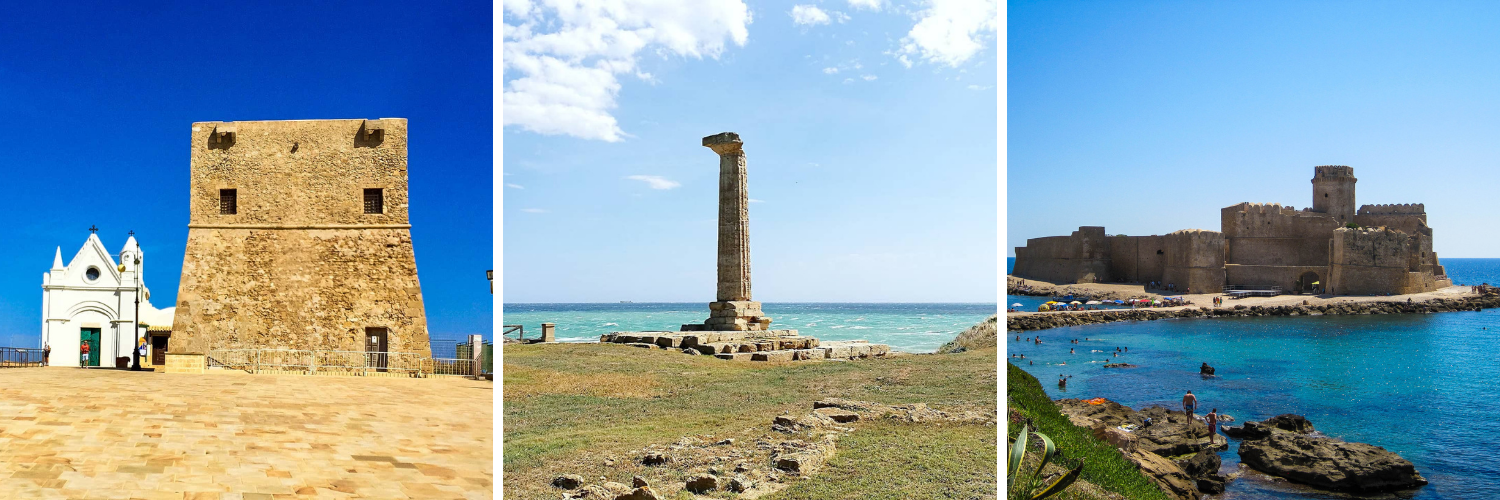Crotone: Discover Calabria
Crotone is a city and commune in Calabria on the Ionian Sea. The city goes back a long way in history, having been founded in 710 BC by Greek settlers who colonized the coastal areas of Southern Italy known as Magna Graecia (which in Latin means “Great Greece”). Even to this day, ancient Greek remains are uncovered.
Crotone is rich with history. It was home to many generations of ancient Olympian champions and has been under the control of the Enotri, the Greeks, the Romans, the Byzantines, as well as, the Bruzi and Franco-German civilizations, such as the Normans, the Svevi, the Angioini and the Bourbons. If you ever studied Maths in school (in particular Geometry) you may have heard of the Pythagorean Theorem which was discovered by a famous Greek mathematician/scientist, Pythagoras, who founded his school in 530 AD in the city of Crotone (which at the time was a Greek colony). His followers became very active in the political situation in Crotone which eventually led to the burning of their meeting places and eventually their fleeing of the city.
WHAT TO SEE:
Capo Colonna

In 6th century B.C a temple dedicated to the goddess Hera was built. All that remains today is one column which is surrounded by the Capo Colonna Archaeological Park. Here you can walk around and see what has been recovered from different excavations, such as the remnants of different buildings and residential areas. The park also has information and illustrations in Italian and English scattered around the park so you can better understand and visualize what you are looking at.

Next to the Archaeological Park, there is the Santuario di Santa Maria di Capo Colonna. According to tradition, the Byzantine painting of the Virgin Mary with the baby Jesus in her arms was stolen by Turkish pirates. When they tried to leave, their ship wouldn’t move so they tried to set fire to the painting and it wouldn’t burn. As a last resort, they threw it into the sea. It was found on a beach by a local fisherman who kept it for most of his life. Today, the painting hangs above the alter in the Santuario.
Castle of Charles V
This castle was built on the highest point of Crotone as a strategic way to keep guard over the sea. It started out as Greek Byzantine fortress and over the centuries was modified and improved. The building as it stands now was designed during the reign of the Spanish kind Charles V and was one of the most powerful fortresses in Italy. It is now home to the town library and civic museum.
Le Castella

Le Castella is one of the seven fortresses that once stood along the gulf. It is quite impressive because it also seems like it is floating in the sea. It sits on an area of land that is connected to the shore by a narrow strip of land. This gives Le Castella the illusion that it’s sitting on the water.
Beaches
Crotone’s coastline sits on the Ionion Sea and has sandy beaches. The colour of the sea changes from sky blue to emerald green.
WHAT TO EAT OR DRINK:
Ciro’ Wine
Percorino Cheese of Crotone
pitta ‘nchiusa – a wonderful Calabrian dessert shaped like a bunch of concentric roses. It is prepared using liquor, dried fruit, honey, sugar, and pine nuts.
Chilli Pepper Grappa
If you’d like to see more photos of Crotone, visit the Calabrisella Mia Facebook page. Don’t forget to like the page!
Comments are closed.

Katja
December 29, 2020 at 11:14 amE’ da tanto che manco da Crotone (mia madre è di Isola e ho passato le mie vacanze qui per ben più di 20 anni) e non sai quanto mi piaccia questa città! All’epoca, il mercato giornaliero si faceva sotto il castello, mi sono innamorata del Museo Archeologico e mi piacerebbe poter visitare il giardino di Pitagora e il relativo (piccolo) museo di arte contemporanea.
LuLu
January 6, 2021 at 7:38 amHo visto solo una piccola parte di questa citta, c’è ancora molto di più che ho bisogno di vedere a Crotone. Spero di poter elaborare presto questo post! 🙂